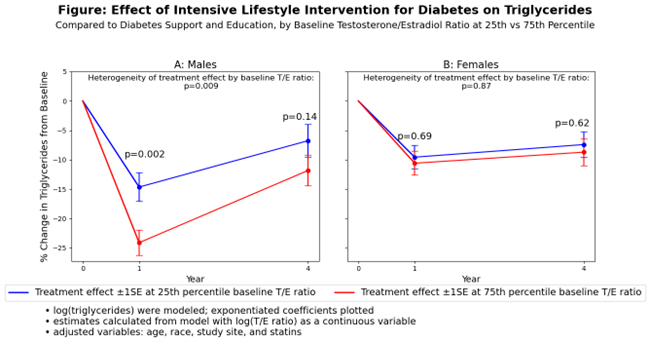Final ID: P2017
Baseline Androgenic State Modifies the Effect of Intensive Lifestyle Intervention on Triglyceride Levels in Males with Diabetes: The Look AHEAD Trial Sex Hormone Study
Abstract Body: Background: In people with type 2 diabetes (T2D), weight loss due to an intensive lifestyle intervention (ILI) reduces triglyceride (TG) levels, a risk factor for cardiovascular disease. However, efficacy of treatment varies between people. Both testosterone and estradiol are associated with TG level. We examined whether baseline androgenic state, i.e., the ratio of testosterone to estradiol (T/E), modifies the treatment effect and partially explains the TG variability.
Methods: The Look AHEAD Study was a randomized control trial of 5145 individuals with T2D and overweight/obesity to evaluate the effect of ILI compared to the control group on cardiovascular outcomes. We selected a random sample of 1166 postmenopausal females and 1166 males (mean age 60 years [SD 6.2]) to examine heterogeneity of treatment effect by baseline T/E ratio on changes in TG at years 1 (weight loss nadir) and 4. We created longitudinal mixed models stratified by sex, and modeled the interaction between log-transformed baseline T/E ratio, ILI (vs control), and year, with log-transformed TG as the outcome. We plotted the estimated treatment effects over time for 25th and 75th percentile of baseline T/E ratio.
Results: Figure, panel A, shows that males with T/E ratio at the 75th percentile (vs 25th percentile) had a larger reduction in TG due to ILI (vs control) at year 1 (p = 0.002), which is no longer statistically significant at year 4 (p = 0.14, overall heterogeneity for both years, p = 0.009). We did not detect any statistically significant heterogeneity in TG levels by T/E ratio for females (panel B, p = 0.87).
Conclusion: Greater baseline androgenic state (T/E ratio) in males, but not females, was associated with a larger reduction in TG due to ILI, compared to the control at year 1 but not year 4. Males with lower T/E ratio might need more aggressive lipid treatment to achieve TG-reducing benefits of ILI.
Methods: The Look AHEAD Study was a randomized control trial of 5145 individuals with T2D and overweight/obesity to evaluate the effect of ILI compared to the control group on cardiovascular outcomes. We selected a random sample of 1166 postmenopausal females and 1166 males (mean age 60 years [SD 6.2]) to examine heterogeneity of treatment effect by baseline T/E ratio on changes in TG at years 1 (weight loss nadir) and 4. We created longitudinal mixed models stratified by sex, and modeled the interaction between log-transformed baseline T/E ratio, ILI (vs control), and year, with log-transformed TG as the outcome. We plotted the estimated treatment effects over time for 25th and 75th percentile of baseline T/E ratio.
Results: Figure, panel A, shows that males with T/E ratio at the 75th percentile (vs 25th percentile) had a larger reduction in TG due to ILI (vs control) at year 1 (p = 0.002), which is no longer statistically significant at year 4 (p = 0.14, overall heterogeneity for both years, p = 0.009). We did not detect any statistically significant heterogeneity in TG levels by T/E ratio for females (panel B, p = 0.87).
Conclusion: Greater baseline androgenic state (T/E ratio) in males, but not females, was associated with a larger reduction in TG due to ILI, compared to the control at year 1 but not year 4. Males with lower T/E ratio might need more aggressive lipid treatment to achieve TG-reducing benefits of ILI.
More abstracts on this topic:
A drug target Mendelian randomization study of triglyceride lowering therapies for aortic stenosis
Ciofani Jonathan, Han Daniel, Gill Dipender, Rao Karan, Allahwala Usaid, Bhindi Ravinay
Age-, Sex- and/or Ethnic- specific disparities; Biventricular systolic and diastolic strain, and biomarker, prognostic implications in Acute Tuberculous Pericarditis.Matshela Mamotabo

